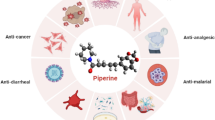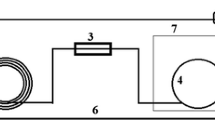Abstract
Macamides with benzylalkylamides structure are a group of characteristic constituents isolated from functional food Maca (Lepidium meyenii Walp.). Previous study demonstrated that macamides are secondary amides, the accumulation of which is associated with drying process. In this study, a rapid method based on ultra-performance liquid chromatography tandem mass spectrometry (UPLC-MS/MS) is developed for the simultaneous detection and determination of macamides in Maca. Validation parameters including linearity, limit of detection, limit of quantification, accuracy, precision, repeatability, and stability were all within the required limits. Seven major macamides are determined by the UPLC method with detection wavelength at 205 nm in 12 min. Based on the fragmentation pattern of standard compounds, four fragment ions (m/z 91, 108, 121, and 138) are selected as diagnostic ions for detection of macamides through precursor ion acquisition mode. Additionally, comparative analysis is performed to examine the effects of different drying processes (air-drying, oven-drying, freeze-drying, and steaming) on Maca (whole hypocotyls and pieces) for macamides. Whole hypocotyls with oven-drying showed the highest content of macamides (2.528 mg/g), while freeze-drying and steaming significantly decrease the amount of macamides. The results provide a reliable method for analysis of macamides and extend previous work insights into the drying process of Maca.




Similar content being viewed by others
References
Ares AM, Nozal MJ, Bernal JL, Bernal J (2014) Effect of temperature and light exposure on the detection of total intact glucosinolate content by LC-ESI-MS in broccoli leaves. Food Anal Methods 7:1687–1692
Bai N, He K, Roller M, Lai CS, Bai L, Pan MH (2015) Flavonolignans and other constituents from Lepidium meyenii with activities in anti-inflammation and human cancer cell lines. J Agric Food Chem 63:2458–2463
Chain FE, Grau A, Martins JC, Catalán CA (2014) Macamides from wild ‘Maca’, Lepidium meyenii Walpers (Brassicaceae). Phytochem Lett 8:145–148
Chan EWC, Lye PY, Eng SY, Tan YP (2013) Antioxidant properties of herbs with enhancement effects of drying treatments: a synopsis. Free Radicals Antioxid 3:2–6
Chen J, Zhao Q, Wang L, Zha S, Zhang L, Zhao B (2015) Physicochemical and functional properties of dietary fiber from maca (Lepidium meyenii Walp.) liquor residue. Carbohydr Polym 132:509–512
Choi EH, Kang JI, Cho JY, Lee SH, Kim TS, Yeo IH, Chun HS (2012) Supplementation of standardized lipid-soluble extract from maca (Lepidium meyenii) increases swimming endurance capacity in rats. J Funct Foods 4:568–573
Cicero AF, Bandieri E, Arletti R (2001) Lepidium meyenii Walp. improves sexual behaviour in male rats independently from its action on spontaneous locomotor activity. J Ethnopharmacol 75:225–229
Ding SH, An KJ, Zhao CP, Li Y, Guo YH, Wang ZF (2012) Effect of drying methods on volatiles of Chinese ginger (Zingiber officinale Roscoe). Food Bioprod Process 90:515–524
Dini A, Migliuolo G, Rastrelli L, Saturnino P, Schettino O (1994) Chemical composition of Lepidium meyenii. Food Chem 49:347–349
Esparza E, Hadzich A, Kofer W, Mithöfer A, Cosio EG (2015) Bioactive maca (Lepidium meyenii) alkamides are a result of traditional Andean postharvest drying practices. Phytochemistry 116:138–148
Gonzales GF (2011) Ethnobiology and ethnopharmacology of Lepidium meyenii (Maca), a plant from the Peruvian highlands. Evid-Based Complement Alternat Med. doi:10.1155/2012/193496
Hermann M, Heller J (1997) Maca Andean roots and tubers: ahipa, arracacha, maca and yacon. International Plant Genetic Resources Institute, Rome, pp 175–194
Kwon J, Kim N, Lee D, Han AR, Lee JW, Seo EK, Lee D (2014) Metabolomics approach for the discrimination of raw and steamed Gastrodia elata using liquid chromatography quadrupole time-of-flight mass spectrometry. J Pharm Biomed Anal 94:132–138
León J (1964) The “Maca” (Lepidium meyenii), a little known food plant of Peru. Econ Bot 18:122–127
Liu X, Qiu Z, Wang L, Chen Y (2011) Quality evaluation of Panax notoginseng extract dried by different drying methods. Food Bioprod Process 89:10–14
Liu H, Jin W, Fu C, Dai P, Yu Y, Huo Q, Yu L (2015) Discovering anti-osteoporosis constituents of maca (Lepidium meyenii) by combined virtual screening and activity verification. Food Res Int. doi:10.1016/j.foodres.2015.06.028
McCollom MM, Villinski JR, McPhail KL, Craker LE, Gafner S (2005) Analysis of macamides in samples of Maca (Lepidium meyenii) by HPLC‐UV‐MS/MS. Phytochem Anal 16:463–469
Montesano C, Sergi M, Moro M, Napoletano S, Romolo FS, Carlo MD, Compagnone D, Curini R (2013) Screening of methylenedioxyamphetamine‐and piperazine‐derived designer drugs in urine by LC–MS/MS using neutral loss and precursor ion scan. J Mass Spectrom 48:49–59
Muhammad I, Zhao J, Dunbar DC, Khan IA (2002) Constituents of Lepidium meyenii ‘maca’. Phytochemistry 59:105–110
Pan Y, Shen T, Pan J, Xiao D, Li Z, Li WY, Wang YZ (2014) Development and validation of a UPLC-MS/MS method for the simultaneous determination and detection of four neuritogenic compounds in different parts of Gentiana rigescens Franch using multiple reaction monitoring and precursor ion scanning. Anal Methods 6:1782–1787
Pan Y, Zhang J, Shen T, Zhao YL, Zuo ZT, Wang YZ, Li WY (2015) Liquid chromatography tandem mass spectrometry combined with fourier transform mid-infrared spectroscopy and chemometrics for comparative analysis of raw and processed Gentiana rigescens. J Liq Chromatogr Relat Technol. doi:10.1080/10826076.2015.1053912
Sun S, Wang CZ, Tong R, Li XL, Fishbein A, Wang Q, Yuan CS (2010) Effects of steaming the root of Panax notoginseng on chemical composition and anticancer activities. Food Chem 118:307–314
Sun TT, Li RR, Zhang ZJ, Gong QF, Qin HL (2015) Investigation of factors affecting the quality of Corydalis yanhusuo samples based on chromatographic fingerprints. J Liq Chromatogr Relat Technol 38:506–513
Uchiyama F, Jikyo T, Takeda R, Ogata M (2014) Lepidium meyenii (Maca) enhances the serum levels of luteinising hormone in female rats. J Ethnopharmacol 151:897–902
Zha S, Zhao Q, Chen J, Wang L, Zhang G, Zhang H, Zhao B (2014) Extraction, purification and antioxidant activities of the polysaccharides from maca (Lepidium meyenii). Carbohydr Polym 111:584–587
Zhao J, Muhammad I, Dunbar DC, Mustafa J, Khan IA (2005) New alkamides from maca (Lepidium meyenii). J Agric Food Chem 53:690–693
Zheng BL, He K, Kim CH, Rogers L, Shao YU, Huang ZY, Zheng QY (2000) Effect of a lipidic extract from Lepidium meyenii on sexual behavior in mice and rats. Urology 55:598–602
Zheng H, Zhang H, Xu LF, Zhang WW, Gan J (2013) Volatile analysis of Maca (Lepidium meyenii Walp.) by TCT-GC/MS. Adv Mater Res 634:1562–1565
Author information
Authors and Affiliations
Corresponding authors
Ethics declarations
Compliance with Ethical Standards
This study was funded by the National Natural Science Foundation of China (31460538) and Key Project of Yunnan Provincial Natural Science Foundation (2013FC006).
Conflict of Interest
Yu Pan, Ji Zhang, Hong Li, Yuan-Zhong Wang, and Wan-Yi Li declare they have no conflicts of interests in relation with this manuscript.
Research Involving Human Participants and/or Animals
This article does not contain any studies with human participants or animals performed by any of the authors.
Informed Consent
Informed consent was obtained from all individual participants included in the study.
Rights and permissions
About this article
Cite this article
Pan, Y., Zhang, J., Li, H. et al. Simultaneous Analysis of Macamides in Maca (Lepidium meyenii) with Different Drying Process by Liquid Chromatography Tandem Mass Spectrometry. Food Anal. Methods 9, 1686–1695 (2016). https://doi.org/10.1007/s12161-015-0346-9
Received:
Accepted:
Published:
Issue Date:
DOI: https://doi.org/10.1007/s12161-015-0346-9




